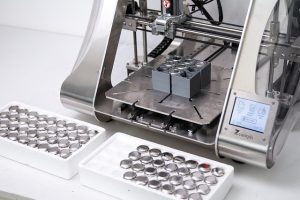
Extrusion is a core component of fused filament fabrication (FFF). During this 3D printing process, a printer will extrude raw material to build the desired object. Most FFF printers use rods or filaments of material. As the material is extruded out of the printer, it’s deposited onto or into the object. To learn more about extrusion and how it works in FFF 3D printing, keep reading.
The Basics of Extrusion
Extrusion, of course, is a process that involves forcing material — typically heated or otherwise softened material — through a die. The die is usually smaller than the tank or container in which the material is stored. Pressure from behind the material then pushes it through the die. As the material is ejected, it features the same uniform shape as the die. There are many different forms of extrusion, but they all involve forcing material through a die.
Why FFF 3D Printers Use Extrusion
FFF 3D printers use extrusion because it allows for a uniform shape and consistency of the deposited material. The material doesn’t just drip from the printer head’s nozzle. Rather, it’s forced out the nozzle so that it takes the same shape and size as nozzle’s die head. As a result, extrusion helps to prevent unwanted material from leaking or dripping out of the nozzle. Unless there’s pressure behind the material, it typically won’t come out.
Types of the FFF Extrusion Processes
While nearly all FFF 3D printers use extrusion, some of them use different extrusion processes than others. Hot extrusion, for instance, involves heating the material prior to extruding it. The material used in hot extrusion typically comes from a rod. As the rod is pushed towards the end of the printer’s head, it’s heated, thus becoming more pliable.
Some FFF 3D printers support the use of pellets for hot extrusion as well. Like with rods, the pellets in these 3D printers are heated prior to being extruded. The granulate pellets consist of thermoplastic that’s heated. Once heated, the pellets are released as liquefied material onto or into the printed object.
Cold extrusion, on the other hand, doesn’t involve heating the material. Rather, it uses powder particles at room temperature that are suspended in a liquid-based solution. The powder particles are still forced out the printer head’s nozzle, but they remain cool and unheated throughout this process. Hopefully, this gives you a better idea of extrusion and how it works in FFF 3D printing.
Learn more about Monroe’s Additive Printing Service or get your parts printed now!
No tags for this post.
